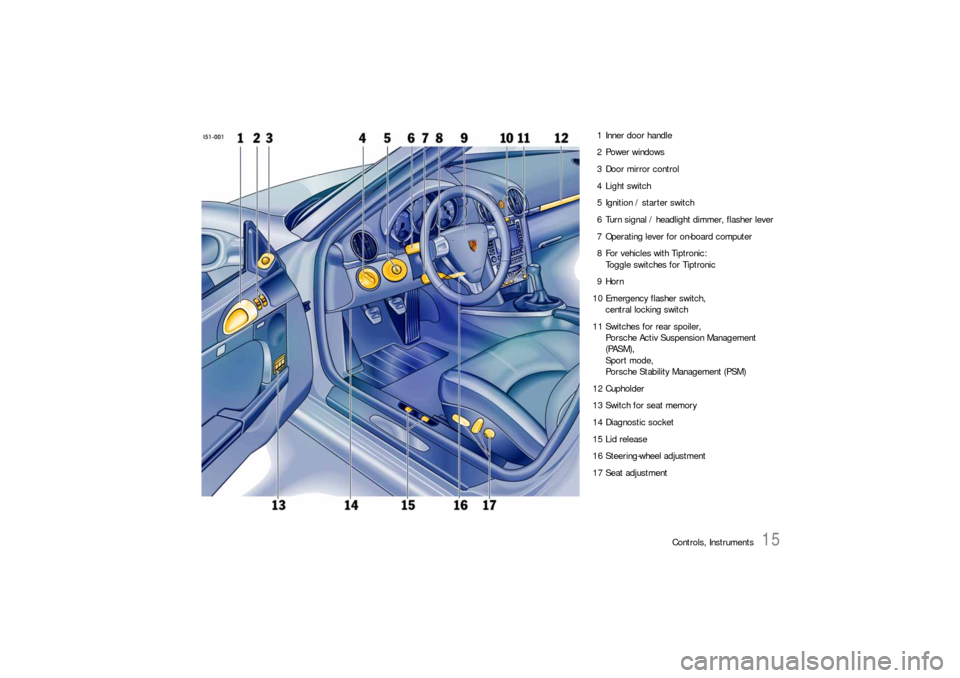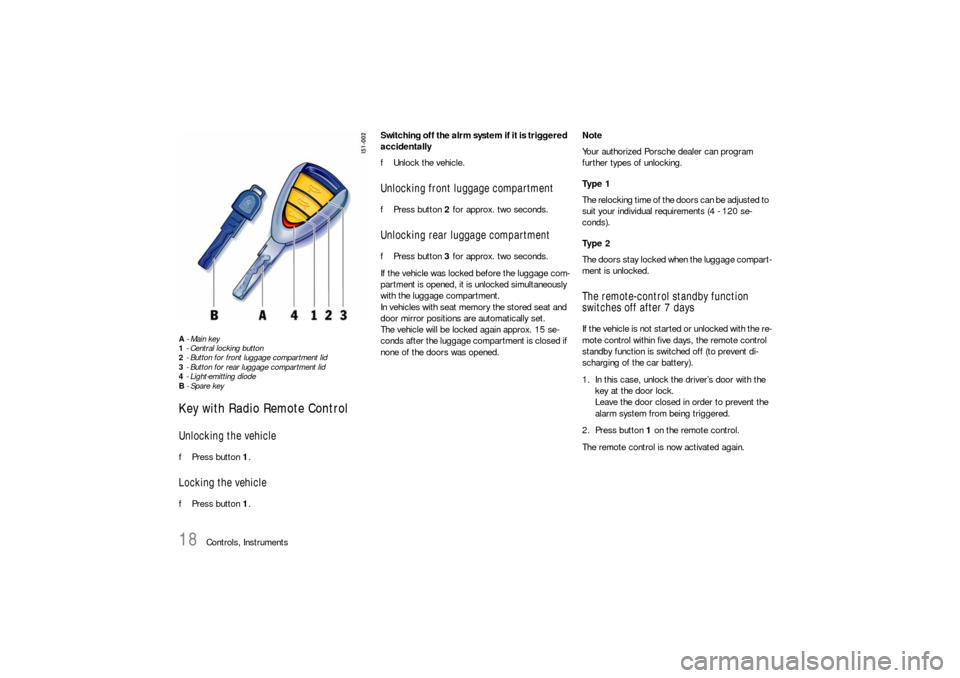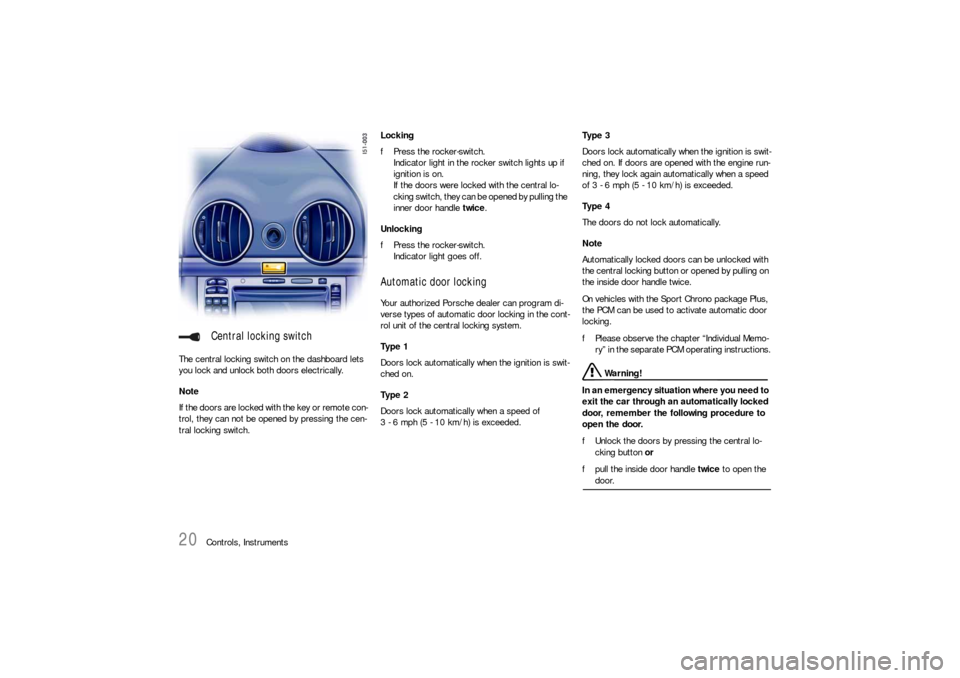PORSCHE BOXSTER 2005 2.G User Guide
Manufacturer: PORSCHE, Model Year: 2005, Model line: BOXSTER, Model: PORSCHE BOXSTER 2005 2.GPages: 276, PDF Size: 4.05 MB
Page 11 of 276

Controls, Instruments
11 Controls, Instruments
Before driving off .......................................... 12
Break in hints for the first
2,000 miles/3,000 kilometers ...................... 14
Keys ........................................................... 17
Security Wheel Bolts .................................... 17
Central Locking in Cars
without Alarm System................................... 19
Doors ......................................................... 25
Alarm System,
Passenger Compartment Monitoring ............. 26
Power Windows ........................................... 28
Inside mirror ................................................ 30
Automatic Anti-Glare
Interior Mirror and Door Mirrors .................... 30
Door Mirrors................................................ 31
Seat Adjustment .......................................... 34
Seat Memory ............................................... 36
Heated Seats .............................................. 38
Steering Wheel Adjustment ........................... 39
Multi-functional steering wheel....................... 40
Sun Visors................................................... 41
Safety Belts................................................. 42
Child Restraint Systems................................ 45
Key-operated airbag deactivation device ........ 46
LATCH System
Child seat bracket on the passenger’s seat .... 47
Key-operated airbag deactivation device ........ 48
Airbag Systems ........................................... 49
Clutch Pedal ................................................ 51
Parking Brake .............................................. 51
Brakes ........................................................ 52ABS Brake System
(Antilock Brake System) ................................ 55
Sport Mode ................................................. 57
Porsche Stability Management (PSM)............. 58
Porsche Active Suspension Management
(PASM) ........................................................ 61
Retractable Spoiler ...................................... 62
Parking Aids ................................................ 64
Ignition/Starter Switch with anti-theft Steering
Lock ........................................................... 67
Starting Procedures ..................................... 69
Stopping engine........................................... 70
Instrument Panel USA Models ....................... 73
Automatic Speed Control Indicator light ......... 76
Instrument Illumination.................................. 76
Trip Odometer ............................................. 77
Speedometer .............................................. 78
Changing over between
Miles / Kilometers........................................ 78
Tachometer ................................................. 79
Turn Signal Indicator Light ............................ 79
High Beam .................................................. 79
Cooling System ........................................... 80
Tiptronic ...................................................... 81
Fuel ............................................................ 82
Clock .......................................................... 83
Outside temperature .................................... 83
Check Engine Warning Light.......................... 84
Central warning light .................................... 85
Brake warning light USA ............................... 85
Brake warning light Canada .......................... 85On-Board Computer (BC)............................... 86
Light Switch .............................................. 108
Welcome Home Lighting............................. 108
Automatic Headlight Beam Adjustment......... 109
Turn Signal/ Headlight Dimmer/Parking light /
Flasher Lever............................................. 109
Windshield Wiper / Washer Lever ................ 110
Automatic Speed Control ............................ 112
Air conditioning .......................................... 114
Automatic air conditioning system ............... 117
Central and side vents................................ 120
Fresh-air intake .......................................... 120
Emergency Flasher Switch .......................... 121
Ashtray ..................................................... 122
Cigarette Lighter ........................................ 123
Sockets .................................................... 124
Interior lights ............................................. 125
Storage in the passenger compartment ....... 126
Cupholder
(holder for drinks cans and cups) ................ 128
Luggage Storage on
Engine Compartment Lid ............................. 130
Fire extinguisher ........................................ 131
Trunk Entrapment ...................................... 132
Luggage compartment lids ......................... 134
Luggage Compartment.............................. 136
Rear luggage compartment ........................ 137
Porsche Communication Management
(PCM) ........................................................ 138
Car Audio Operation/Tips ........................... 139
HomeLink .................................................. 142
Page 12 of 276

12
Controls, Instruments
Dear Porsche Owner A lot has gone into the manufacture of your
Porsche, including advanced engineering, rigid
quality control and demanding inspections.
These engineering and safety features will be
enhanced by you... the safe driver... – who knows his car and all controls,
– who maintains the vehicle properly,
– who uses driving skills wisely, and always
drives within her/his own capabilities and the
level of familiarity with the vehicle.
You will find helpful hints in this manual on how to
perform most of the checks listed on the following
pages.
If in doubt, have these checks performed by your
authorized Porsche dealer.
Before driving off... Check the following items first fTurn the engine off before you attempt any
checks or repairs on the vehicle.
fBe sure the tires are inflated correctly.
Check tires for damage and tire wear.
fSee that wheel bolts are properly tightened
and not loose or missing.
fCheck engine oil level, add if necessary.
Make it a habit to have engine oil checked with
every fuel filling.
fCheck all fluid levels such as windshield was-
her and brake fluid levels.
fBe sure the vehicle battery is well charged and
cranks the engine properly.
fCheck all doors and lids for proper operation
and latch them properly.
fCheck and if necessary replace worn or cra-
cked wiper blades.
fSee that all windows are clear and unobstruc-
ted.
fCheck air intake slots and area between front
lid and windshield are free of snow and ice, so
the heater and the windshield wipers work pro-
perly. fIf a child will be riding in the vehicle, check
child seat/child seat restraint system to ensure
that restraints are properly adjusted.
fCheck all exterior and interior lights for opera-
tion and that the lenses are clean.
fCheck the headlights for proper aim, and if ne-
cessary, have them adjusted.
fCheck under the vehicle for leaks.
fBe sure all luggage is stowed securely.
Emergency equipment It is good practice to carry emergency equipment
in your vehicle.
Some of the items you should have are:
window scraper, snow brush, container or bag of
sand or salt, emergency light, small shovel, first-
aid kit, etc.
Page 13 of 276

Controls, Instruments
13
In the driver’s seat... fCheck operation of the horn.
fPosition seat for easy reach of foot pedals and
controls.
To reduce the possibility of injury from the air-
bag deployment, you should always sit back as
far from the steering wheel as is practical,
while still maintaining full vehicle control.
fAdjust the inside and outside rear view mirrors.
fBuckle your safety belts.
fCheck operation of the foot and parking brake.
fCheck all warning and indicator lights with
ignition on and engine not running.
fStart engine and check all warning displays for
warning symbols.
fNever leave an idling car unattended.
fLock doors from inside, especially with child-
ren in the car to prevent inadvertent opening of
doors from inside or outside.
Drive with doors locked.
On the road... fNever drive after you have consumed alcohol
or drugs.
fAlways have your safety belt fastened.
fAlways drive defensively.
Expect the unexpected.
fUse signals to indicate turns and lane changes.
fTurn on headlights at dusk or when the driving
conditions warrant it.
fAlways keep a safe distance from the vehicle in
front of you, depending on traffic, road and
weather conditions.
fReduce speed at night and during inclement
weather.
Driving in wet weather requires caution and re-
duced speeds, particularly on roads with stan-
ding water, as the handling characteristics of
the vehicle may be impaired due to hydropla-
ning of the tires.
fAlways observe speed limits and obey road
signs and traffic laws.
fWhen tired, get well off the road, stop and take
a rest. Turn the engine off. Do not sit in the ve-
hicle with engine idling.
fPlease observe the chapter “ENGINE EX-
HAUST” on Page 8.fWhen parked, always set the parking brake.
Move the Tiptronic selector lever to ”P“ or the
gearshift lever to reverse or first gear.
On hills also turn the front wheels toward the
curb.
fWhen emergency repairs become necessary,
move the vehicle well off the road. Turn on the
emergency flasher and use other warning de-
vices to alert other motorists. Do not park or
operate the vehicle in areas where the hot ex-
haust system may come in contact with dry
grass, brush, fuel spill or other flammable ma-
terial.
fMake it a habit to have the engine oil checked
with every fuel filling.
Danger!
Danger of fire in engine compartment due to
burning cigars or cigarettes.
fDo not throw any lit cigars or cigarettes out of
the vehicle.
They can be blown into the air inlets by the air
flow and cause a fire in the engine compart-
ment.
fPlease observe the chapter “ASHTRAY” on Page 122.
Page 14 of 276

14
Controls, Instruments
Break in hints for the first
2,000 miles/3,000 kilometers The following tips will be helpful in obtaining opti-
mum performance from your new Porsche.
Despite the most modern, high-precision manufac-
turing methods, it cannot be completely avoided
that the moving parts have to wear in with each
other. This wearing-in occurs mainly in the first
2,000 miles/3,000 km. Therefore: fPreferably take longer trips.
fAvoid frequent cold starts with short-distance
driving whenever possible.
fAvoid full throttle starts and abrupt stops.
fDo not exceed maximum engine speed of
4,200 rpm (revolutions per minute).
fDo not run a cold engine at high rpm either in
Neutral or in gear.
fDo not let the engine labor, especially when dri-
ving uphill. Shift to the next lower gear in time
(use the most favorable rpm range).
fNever lug the engine in high gear at low
speeds. This rule applies at all times, not just
during the break-in period. fDo not participate in motor racing events,
sports driving schools, etc. during the first
2,000 miles/3,000 kilometers.
There may be a slight stiffness in the steering,
gear-shifting or other controls during the break-in
period which will gradually disappear.
Break in brake pads and break discsNew brake pads and discs have to be “broken in”,
and therefore only attain optimal friction when the
car has covered several hundred miles or km.
The slightly reduced braking ability must be com-
pensated for by pressing the brake pedal harder.
This also applies whenever the brake pads and
brake discs are replaced. New tires New tires do not have maximum traction. They
tend to be slippery.
fBreak in new tires by driving at moderate
speeds during the first 60 to 120 miles/100 to
200 km. Longer braking distances must be an-
ticipated.
Engine oil consumption During the break-in period oil consumption may be
higher than normal.
As always, the rate of oil consumption depends on
the quality and viscosity of oil, the speed at which
the engine is operated, the climate and road con-
ditions, as well as the amount of dilution and oxi-
dation of the lubricant.
fMake a habit of checking engine oil with every
fuel filling, add if necessary.
Page 15 of 276

Controls, Instruments
15
1 Inner door handle
2 Power windows
3 Door mirror control
4 Light switch
5 Ignition / starter switch
6 Turn signal / headlight dimmer, flasher lever
7 Operating lever for on-board computer
8 For vehicles with Tiptronic:
Toggle switches for Tiptronic
9Horn
10 Emergency flasher switch,
central locking switch
11 Switches for rear spoiler,
Porsche Activ Suspension Management
(PASM),
Sport mode,
Porsche Stability Management (PSM)
12 Cupholder
13 Switch for seat memory
14 Diagnostic socket
15 Lid release
16 Steering-wheel adjustment
17 Seat adjustment
Page 16 of 276

16
Controls, Instruments
Never invite car theft! An unlocked car with the key in the ignition lock in-
vites car theft.
A steering wheel lock and a gong alarm are stan-
dard equipment in your Porsche.
The gong alarm will sound if you open the driver’s
door while the key is still in the ignition lock. It is
your reminder to pull the key out of the ignition
lock and to lock the doors.
Warning!
Any uncontrolled movement of the vehicle
may result in serious personal injury and pro-
perty damage.
Never leave your vehicle unattended with the
key in the ignition lock, especially if children
and/or pets are left unattended in the vehic-
le. They can operate power windows and
other controls. If the engine is left running,
they may accidentally engage the shift lever.
fAlways remove the ignition key.
fAlways set the parking brake.
fLock the doors with the key or with the remote control.
Warning!
Risk of a serious accident.
The steering column will lock when you re-
move the key while you are driving or as the
car is rolling to a stop. You will not be able to
steer the car.
fNever remove the key from the steering lock while you are driving. To protect your vehicle and your possessions
from theft, you should always proceed as fol-
lows when leaving your vehicle:
fClose windows.
fClose convertible top
(with the convertible top open, the passenger
compartment monitoring system is always
switched off).
fLock glove compartment.
fRemove ignition key.
fClose storage tray between the seats.
fRemove valuables (e.g. car documents, tele-
phone, house keys) from the car.
fLock doors.
Page 17 of 276

Controls, Instruments
17
Keys fPlease observe the chapter “CENTRAL LO-
CKING IN CARS WITH ALARM SYSTEM” on
Page 21.
Two main keys and one spare key are supplied
with your Porsche.
These keys operate all the locks on your vehicle.
fBe careful with your car keys: do not part with
them except under exceptional circumstances.
fTo avoid battery run-down, always remove the
ignition key from the ignition lock.
Replacement keys Replacement car keys can be obtained only from
your authorized Porsche dealer, and this can so-
metimes be very time-consuming.
You should therefore always keep the spare key on
your person.
Keep it in a safe place (e.g. wallet), but under no
circumstances in or on the vehicle.
The key codes of new keys have to be “reported”
to the car control unit by your authorized Porsche
dealer.
The key grip of the spare key can be exchanged
for a main-key grip.
Disabling key codes
If a key is lost, the key codes can be disabled by
an authorized Porsche dealer.
All the remaining car keys are required for this pur-
pose.
Disabling the code ensures that the car can be
started only using authorized keys.
Note
fPlease note that the other locks can still be
opened with the disabled key.
Immobilizer There is a transponder (an electronic component)
in the key grip, containing a stored code.
When the ignition is switched on, the ignition lock
checks the code.
The immobilizer can be deactivated and the engi-
ne started only using an authorized ignition key.
Switching off the immobilizer
fInsert the ignition key into the ignition lock.
If the ignition is left on for more than 2 minutes
without starting the engine, the immobilizer is re-
activated.
fIf this happens, turn the ignition key back to the
3 position before starting the engine.
Please observe the chapter “IGNITION/STAR-
TER SWITCH WITH ANTI-THEFT STEERING
LOCK” on Page 68.
Switching off the immobilizer
fRemove ignition key.Security Wheel Bolts fIf wheels have to be removed during a work-
shop visit, do not forget to hand over the so-
cket for the security wheel bolts along with the
car key.
Page 18 of 276

18
Controls, Instruments
A - Main key
1 - Central locking button
2 - Button for front luggage compartment lid
3 - Button for rear luggage compartment lid
4 - Light-emitting diode
B - Spare key Key with Radio Remote ControlUnlocking the vehiclefPress button 1.Locking the vehiclefPress button 1.Switching off the alrm system if it is triggered
accidentally
fUnlock the vehicle.
Unlocking front luggage compartment fPress button 2 for approx. two seconds. Unlocking rear luggage compartment fPress button 3 for approx. two seconds.
If the vehicle was locked before the luggage com-
partment is opened, it is unlocked simultaneously
with the luggage compartment.
In vehicles with seat memory the stored seat and
door mirror positions are automatically set.
The vehicle will be locked again approx. 15 se-
conds after the luggage compartment is closed if
none of the doors was opened. Note
Your authorized Porsche dealer can program
further types of unlocking.
Ty p e 1
The relocking time of the doors can be adjusted to
suit your individual requirements (4 - 120 se-
conds).
Ty p e 2
The doors stay locked when the luggage compart-
ment is unlocked.
The remote-control standby function
switches off after 7 days If the vehicle is not started or unlocked with the re-
mote control within five days, the remote control
standby function is switched off (to prevent di-
scharging of the car battery).
1. In this case, unlock the driver’s door with the
key at the door lock.
Leave the door closed in order to prevent the
alarm system from being triggered.
2. Press button 1 on the remote control.
The remote control is now activated again.
Page 19 of 276

Controls, Instruments
19
Central Locking in Cars without
Alarm System This device complies with:
Part 15 of the FCC Rules
RSS-210 of Industry Canada.
Operation is subject to the following two condi-
tions:
1. This device may not cause harmful interfer-
ence, and
2. this device must accept any interference re-
ceived, including interference that may cause
undesired operation.
Note
The manufacturer is not responsible for any radio
or TV interference caused by unauthorized modifi-
cations to this equipment.
Such modification could void the user’s authority
to operate the equipment.
Warning!
Any changes or modifications not expressly appro-
ved by Porsche could void the user’s authority to
operate this equipment.
fPlease observe the chapter “LOAD SWITCH-
OFF AFTER 2 HOURS OR 7 DAYS” on Page
226.
fPlease observe the chapter “SEAT MEMORY”
on Page 36.fPlease observe the chapter “POWER WIN-
DOWS” on Page 28.
Both car doors and the filler flap can be centrally
unlocked or locked with the remote control.
Any person remaining in the locked car can
open the door with the inner door handle:
1. Pull inner door handle once to unlock door
lock.
2. Pull inner door handle again to open door.
Automatic relocking If the car is unlocked by remote control and none
of the car doors is opened within approx. 60 se-
conds, automatic relocking takes place.
This relocking time can be adapted to your indivi-
dual requirements (4 - 120 seconds) by an autho-
rized Porsche dealer.
Emergency operation – opening fUnlock the driver’s door with the key at the
door lock. Emergency operation – closing fLock the driver’s door with the key at the door
lock.
If there is a defect in the central locking sys-
tem, all functioning elements of the central lo-
cking system will be locked.
The fault should be remedied immediately at an
authorized Porsche dealer. Indication by emergency flasher If the remote control is used for unlocking or lo-
cking, a response is provided by the emergency
flasher:
– Unlocking – single flash.
– Locking – double flash. Overload protection If the central locking system is operated more
than ten times within a minute, further operation is
blocked for 30 seconds.
Page 20 of 276

20
Controls, Instruments The central locking switch on the dashboard lets
you lock and unlock both doors electrically.
Note
If the doors are locked with the key or remote con-
trol, they can not be opened by pressing the cen-
tral locking switch. Locking
fPress the rocker-switch.
Indicator light in the rocker switch lights up if
ignition is on.
If the doors were locked with the central lo-
cking switch, they can be opened by pulling the
inner door handle twice.
Unlocking
fPress the rocker-switch.
Indicator light goes off.
Automatic door locking Your authorized Porsche dealer can program di-
verse types of automatic door locking in the cont-
rol unit of the central locking system.
Ty p e 1
Doors lock automatically when the ignition is swit-
ched on.
Ty p e 2
Doors lock automatically when a speed of
3 - 6 mph (5 - 10 km/h) is exceeded. Ty p e 3
Doors lock automatically when the ignition is swit-
ched on. If doors are opened with the engine run-
ning, they lock again automatically when a speed
of 3 - 6 mph (5 - 10 km/h) is exceeded.
Ty p e 4
The doors do not lock automatically.
Note
Automatically locked doors can be unlocked with
the central locking button or opened by pulling on
the inside door handle twice.
On vehicles with the Sport Chrono package Plus,
the PCM can be used to activate automatic door
locking.
fPlease observe the chapter “Individual Memo-
ry” in the separate PCM operating instructions.
Warning!
In an emergency situation where you need to
exit the car through an automatically locked
door, remember the following procedure to
open the door.
fUnlock the doors by pressing the central lo-
cking button or
fpull the inside door handle twice to open the door.
Central locking switch